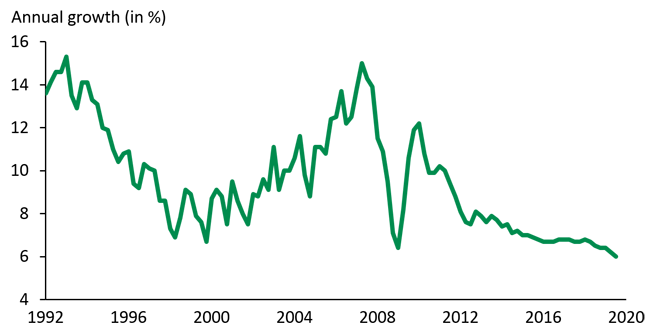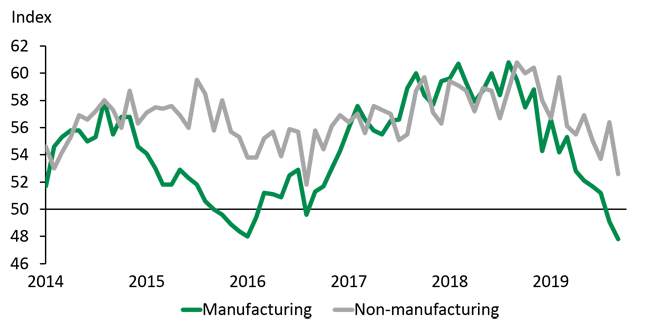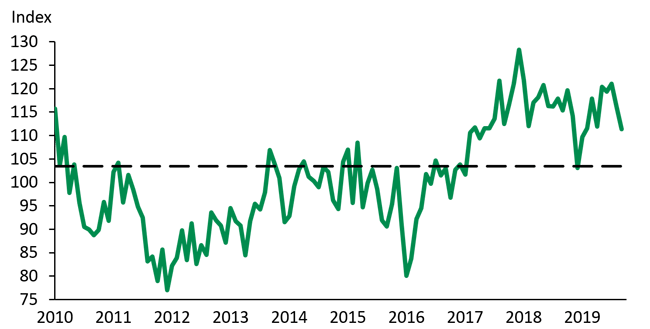A gloomier outlook for the global economy
The negative impacts of the ongoing trade tensions on the global economy are becoming more and more visible. Global trade remains stagnant while the threat of new tariffs, particularly between China and the United States, continues to undermine business investment and harm the prospects of the manufacturing sector. In the eurozone, Germany is probably already in recession while France has shown some resilience. And despite a new withdrawal agreement, Brexit is still far from a done deal and the issue risks negatively impacting the UK’s economic outlook. China’s growth slowdown continued in the third quarter, posting annual real GDP growth of 6.0%, the lowest level in decades (see Graph 1).
Graph 1 – The continuing economic slowdown in China

Sources: National Bureau of Statistics and Desjardins Economic Studies
After climbing 3.6% in 2018, global real GDP should grow by only 3.1% in 2019 and 3.0% in 2020. The current period of weak global economic growth could persist until 2021. Measures taken by central banks this year, like the interest rate cuts in the United States, will help limit the damage but are unlikely to fuel a sustainable growth acceleration if current levels of uncertainty throughout the world persist. Absent a clear (positive or negative) outcome in the trade negotiations between China and the United States, the next few months could see no clear trend in the performance of the stock markets, bond yields and the Canadian dollar. Much will depend on whether the US opts to suspend a new round of tariffs set to go into effect in mid-December.
In the United States, more and more signs of economic slowdown have emerged, although the trend has not spread to the whole economy. The ISM indexes (see Graph 2) and several labour market indicators are pointing in a negative direction. However, unemployment has hit a new low and some consumer confidence indicators are up. Real GDP growth should be just under 2% in the third quarter, though could it further weaken if trade tensions remain high. Against this backdrop, US growth forecasts for 2020 have been lowered and now stand at only 1.6% real GDP growth compared to 2.3% for 2019.
Graph 2 – The drop in the ISM indexes is starting to cause alarm in the United States

Sources: Institute for Supply Management and Desjardins Economic Studies
The situation is more encouraging in Canada, whose economic vitality has taken observers by surprise in recent months. The gradual resumption of oil production in Alberta helped Canada’s real GDP growth reach 3.7% (annualized) in spring. For the third quarter, observers anticipate real GDP growth of 1.7%. Consumer spending and residential investment have been boosted by a robust labour market and high consumer confidence (see Graph 3). However, uncertainty surrounding foreign trade and non-residential investment remains present and is likely to continue to weigh on Canada’s growth. The resilience of the domestic economy has led the Bank of Canada to leave its benchmark interest rate unchanged since the beginning of 2019. This status quo should persist into the coming quarters, with the decline in bond yields and mortgage rates already supporting Canada’s economy while raising fresh concerns over household debt.
Graph 3 – Canadian consumer confidence is high

Sources: Conference Board of Canada and Desjardins Economic Studies
Quebec continues to be a strong performer. Despite the mounting difficulties in foreign trade, Quebec’s economy kept up a brisk pace in the first half of the year. Real GDP growth even approached 3% (annualized) in the second quarter. Job creation remains strong and unemployment stands near its historical monthly low of 4.7%. Meanwhile, the residential real estate market has reached new heights in terms of sales and prices. Despite this positive picture, Quebec’s economic growth is expected to slow down to around 1.5% in the second half of 2019 and in 2020 as the province's exports are weakened by trade conflicts and a cooling global economy.
